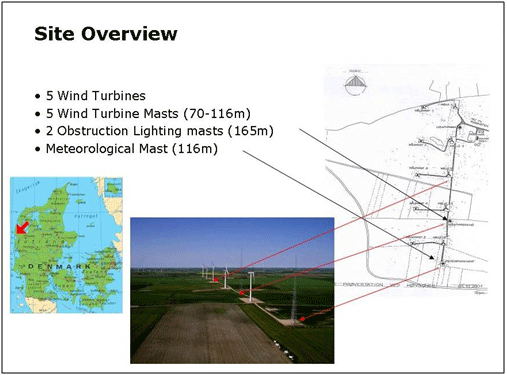Inflow measurements on the Siemens 3.6 MW turbine
The increase in wind turbine rotor size with rotor diameters up to above 120 m has led to bigger variation of inflow characteristics over the rotor plane. Considerable wind shear gives higher rotor moments and influences the aerodynamic performance of the turbine. It also complicates the measurement of rotor performance as the standard so far has been to use a hub height cup anemometer some distance upstream the turbine which does not necessary give a wind speed that is a good measure of the average wind speed over the rotor area. There is thus a need for detailed information of inflow characteristics (shear as well as turbulence characteristics) over the rotor plane. The standard technique for obtaining such information has for a long time been a meteorology mast with a suitable instrumentation of anemometers, wind direction vanes and sonics. Within the last few years sodar and lidar techniques have been introduced and this seems to be promising techniques although still expensive.
In the past we have investigated a new approach which is based on the measurement of the inflow on the rotating blade of a rotor. So far we have used a five hole pitot tube which gives the magnitude of the flow velocity and two flow angles. The main advantages with this measurement technique are; 1) the flow sensor scans along a circular path on the swept rotor area; 2) the measurement is performed at exactly the position of the operating rotor and 3) the instrumentation is relatively cheap. The main disadvantage is that the measured data have to be corrected for the influence of the rotor if it shall correspond to free inflow conditions.
In the present project wind shear and turbulence data have been investigated on basis of inflow measurements on the Siemens 3.6 MW turbine at the Høvsøre Test site for MW turbines. In March 2007 a five hole pitot tube was installed at a radius of 36 m (107 m diameter rotor) on the Siemens 3.6 MW turbine at the Høvsøre test site in Jutland (DK) Figure 1, for measurement of local inflow angle and relative velocity. The Høvsøre test site is the Danish centre for testing MW turbines and is situated a few kilometres from the west cost of Jutland. In total five turbines are installed along a row at the test site and the Siemens turbine is situated in the middle of this row so the turbine will operate in wake of other turbines for some wind directions, The signals from the pitot tube have been sampled at 35 Hz together with a number of signals from the turbine such as electrical power and rotor rpm.
 |
 |
Figure 1. The five hole pitot tube mounted in radius 36 m on the blade in a distance of about 0.80 m in front of the leading edge of the blade. Rotor diameter is 107 m.

Figure 2. The Høvsøre test site in Jutland. The Siemens 3.6 MW turbine is situated as the middle turbine in the row of 5 turbines.